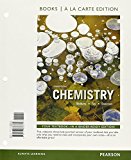
Interpretation:
The fraction of the molecules in a gas at 300 K, which collide with energy equal to or greater than Ea. and the fraction of the molecules in the gas at the same temperatureif Ea is doubled should be identified.
Concept introduction:
Based on collision theory, a reaction takes place because the reactant molecules collide with each other. However, if the collision is not effective, it does not turn into products. Hence, in order to achieve a product, there must be effective collision taking place. If any molecule can perform effective collisions, there must be some energy. This energy is always greater than the minimum energy of a molecule possesses called Threshold Energy. Any energy which greater than this energy is called Activation Energy, which isa must to form a product from the reactants.
Therefore, Activation Energy = Threshold Energy − Average kinetic energy of reactants.
From the given Activation Energy, we can calculate the number of fraction of molecules in any of the gaseous reaction at a given temperature.
Given:
Temperature = 300K
Activation Energy = Ea = 50 kJ/mol.
Activation Energy = Ea = 100 kJ/mol.
Want to see the full answer?
Check out a sample textbook solution
Chapter 13 Solutions
Chemistry, Books a la Carte Edition and Modified Mastering Chemistry with Pearson eText & ValuePack Access Card (7th Edition)
 ChemistryChemistryISBN:9781305957404Author:Steven S. Zumdahl, Susan A. Zumdahl, Donald J. DeCostePublisher:Cengage Learning
ChemistryChemistryISBN:9781305957404Author:Steven S. Zumdahl, Susan A. Zumdahl, Donald J. DeCostePublisher:Cengage Learning ChemistryChemistryISBN:9781259911156Author:Raymond Chang Dr., Jason Overby ProfessorPublisher:McGraw-Hill Education
ChemistryChemistryISBN:9781259911156Author:Raymond Chang Dr., Jason Overby ProfessorPublisher:McGraw-Hill Education Principles of Instrumental AnalysisChemistryISBN:9781305577213Author:Douglas A. Skoog, F. James Holler, Stanley R. CrouchPublisher:Cengage Learning
Principles of Instrumental AnalysisChemistryISBN:9781305577213Author:Douglas A. Skoog, F. James Holler, Stanley R. CrouchPublisher:Cengage Learning Organic ChemistryChemistryISBN:9780078021558Author:Janice Gorzynski Smith Dr.Publisher:McGraw-Hill Education
Organic ChemistryChemistryISBN:9780078021558Author:Janice Gorzynski Smith Dr.Publisher:McGraw-Hill Education Chemistry: Principles and ReactionsChemistryISBN:9781305079373Author:William L. Masterton, Cecile N. HurleyPublisher:Cengage Learning
Chemistry: Principles and ReactionsChemistryISBN:9781305079373Author:William L. Masterton, Cecile N. HurleyPublisher:Cengage Learning Elementary Principles of Chemical Processes, Bind...ChemistryISBN:9781118431221Author:Richard M. Felder, Ronald W. Rousseau, Lisa G. BullardPublisher:WILEY
Elementary Principles of Chemical Processes, Bind...ChemistryISBN:9781118431221Author:Richard M. Felder, Ronald W. Rousseau, Lisa G. BullardPublisher:WILEY





